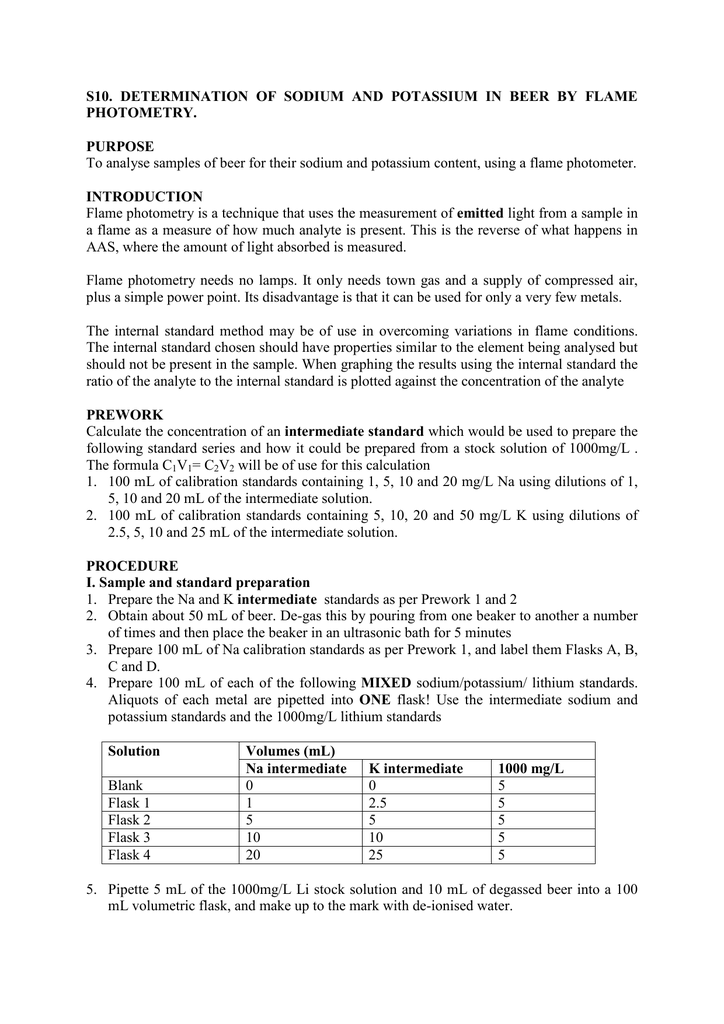Determination of Sodium by Flame Emission Spectroscopy
Behari JR Prakash R. Gamma spectroscopy is a radionuclide measurement method.

S10 Determination Of Sodium And Photometry Purpose
What are the ten uses of atomic emission spectroscopy.

. Aqueous film forming foam. Atomic absorption spectrometry AAS is a very sensitive method of elemental analysis allowing the determination of metals in a variety of samples at the picogram level. Along with isotope ratio mass.
A calibration curve is one approach to the problem of instrument calibration. Infrared spectroscopy 76 Raman spectroscopy 50 Electron energy loss spectroscopy 21 Dynamic light scattering 17 Fluorescence spectroscopy 17 Absorption spectroscopy 8 Surface plasmon resonance spectroscopy 3 Scanning tunneling spectroscopy 3 Circular dichroism spectroscopy 1 Emission spectroscopy 1 Electrochemistry. The application of flame atomic absorption spectrometry for gold determination in some of its bearing rocks.
Determination of total arsenic content in water by atomic absorption spectroscopy AAS using vapour generation assembly VGA. Summary of Method 21 In direct aspiration atomic absorption spectroscopy a sample is aspirated and atomized in a flame A light beam from a hollow cathode lamp whose cathode is made of the element to be determined is directed through the flame into a monochromator and onto a detector that measures the amount of light absorbed Absorption. Which of the following spectroscopy techniques is associated with molecular emission.
Other standard approaches may mix the. He mapped over 570 lines designating the principal features. While a Geiger counter determines only the count rate a gamma spectrometer will determine the energy and the count rate of gamma-rays emitted by radioactive substances.
This website uses cookies to help provide you with the best possible online experience. The determination of trace metals in solution. Please read our Terms Conditions and Privacy Policy for information about.
Atomic emission spectroscopy ICP-AESPES is used in. Some of the important types of Spectroscopic Techniques are as follows. In 1814 Fraunhofer independently rediscovered the lines and began to systematically study and measure the wavelengths where these features are observed.
Atomic absorption spectroscopy AAS and atomic emission spectroscopy AES are Spectro analytical procedures that use the absorption of optical radiation light by free atoms in the gaseous state to determine chemical elements quantitatively. Of urine has also been reported by observing change in the concentration of sodium and calcium in samples undergoing flame atomic absorption spectroscopy Santos et al. The ash content is a measure of the total amount of minerals present within a food whereas the mineral content is a measure of the amount of specific inorganic components present within a food such as Ca Na K and ClDetermination of the ash and mineral content of foods is important for a number of reasons.
Determination of geographical origin of milk has been possible using ICP-OES Inductively Coupled Plasma Emission Spectroscopy. Potts in Treatise on Geochemistry Second Edition 2014 1592 Some History. Atomic spectroscopy has seen a range of influential discoveries and developments over the last 400 years and a fascinating time line of these developments has been published by Thomsen 2006Arguably the key scientific discovery that established optical atomic spectrometry was.
Association of Analytical Chemists. American Public Health Association. The analysis of agricultural materials.
If the above compound was completely reduced what will be the possible transitions it can undergo. Analysis of Ash and Minerals. 2-Amino-3-5-methyl-3-oxo-12- oxazol-4-yl propanoic acid.
Also known as. Butcher in Encyclopedia of Analytical Science Second Edition 2005 Introduction. The absorption of light by free metallic ions is the basis for atomic absorption spectroscopy.
The detection of metal deficiency in soils and plants. Flame photometer can be used to determine the concentration of certain metal ions like sodium potassium lithium calcium and cesium etc. It is also known as flame emission spectroscopy.
Atomic emission spectroscopy. A np b ss c pp d ns ss. ASTM International formerly the American Society for.
In analytical chemistry a calibration curve also known as a standard curve is a general method for determining the concentration of a substance in an unknown sample by comparing the unknown to a set of standard samples of known concentration. In 1802 the English chemist William Hyde Wollaston was the first person to note the appearance of a number of dark features in the solar spectrum. Clinical diagnosis of different metals ie Na K Ca Mg etc in body fluids.
Flame photometry is one of the branches of atomic absorption spectroscopy. It has been used for thousands of applications involving a wide diversity of samples. Atomic fluorescence spectroscopy.
Currently it has become a necessary tool in the field of analytical chemistry.

Flame Photometry An Overview Sciencedirect Topics

Analysis Of Flame Emission Spectroscopy And Atomic Absorption Download Scientific Diagram

Emission Spectra And Photographs From The Flame Tests Of Lithium Download Scientific Diagram

Pdf An Experimental Demonstration Of A Multi Element Flame Photometer Determination Of Salt Concentration In Soy Sauce Semantic Scholar

The Bwb Xp Is The First And Only 5 Channel Flame Photometer With Simultaneous Detection And Display Of All 5 Elements The Technology Flames Modern Technology

Comments
Post a Comment